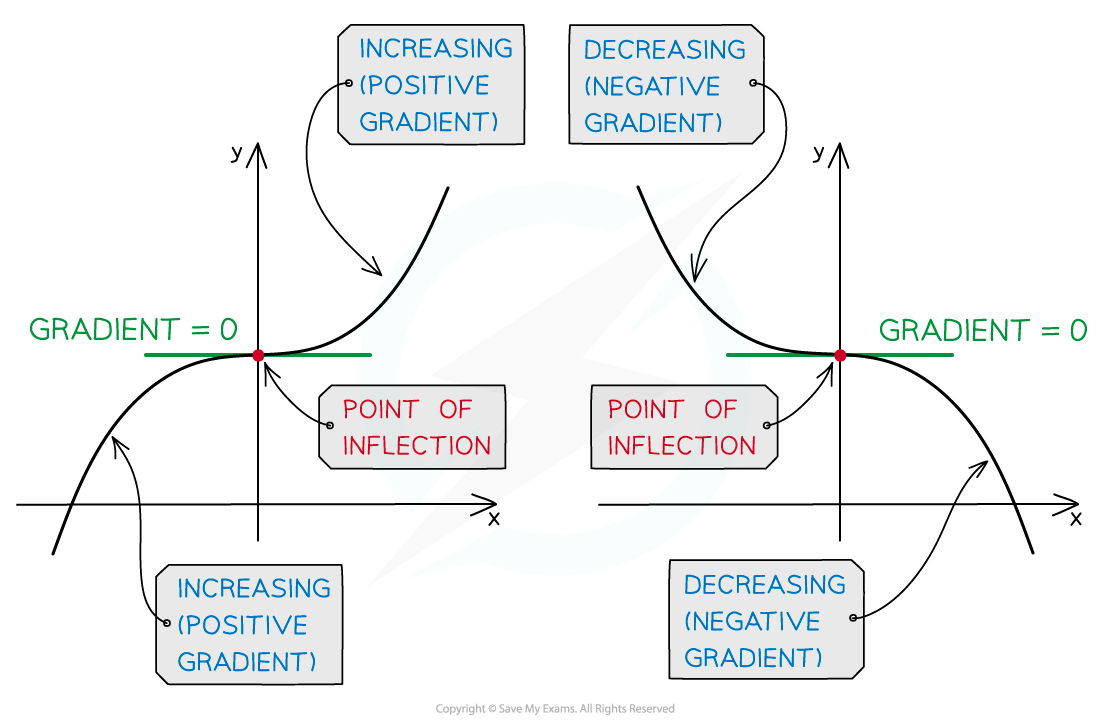Stationary Points (DP IB Applications & Interpretation (AI)): Revision Note
Did this video help you?
Stationary points & turning points
What is the difference between a stationary point and a turning point?
A stationary point is a point at which a function's gradient function is equal to zero
The tangent to the curve of the function is horizontal
A turning point is a type of stationary point
But in addition the function changes at a turning point
from increasing to decreasing
or from decreasing to increasing
The curve ‘turns’ from ‘going upwards’ to ‘going downwards’ or vice versa
Turning points will either be (local) minimum or maximum points
A point of inflection could also be a stationary point but is not a turning point
How do I find stationary points and turning points?
For the function
, stationary points (including turning points) can be found using the following process
STEP 1
Find the gradient function,
STEP 2
Solve the equation
to find the
-coordinate(s) of any stationary points
Remember that turning points are a type of stationary point
STEP 3
If the
-coordinates of the stationary points are also required then substitute the
-coordinate(s) into
Examiner Tips and Tricks
A GDC will solve and most will find the coordinates of turning points (minimum and maximum points) in graphing mode.
Did this video help you?
Testing for local minimum & maximum points
What are local minimum and maximum points?
Local minimum and maximum points are two types of stationary point
The gradient function (derivative) at such points equals zero
i.e.
A local minimum point,
will be the lowest value of
in the local vicinity of the value of
The function may reach a lower value further away from the point
Similarly, a local maximum point,
will be the highest value of
in the local vicinity of the value of
The function may reach a greater value further away from the point
The nature of a stationary point refers to whether it is a local minimum point, a local maximum point or a point of inflection
A global minimum point would represent the lowest value of
for all values of
similar for a global maximum point
Examiner Tips and Tricks
The graphs of many functions tend to plus or minus infinity for large positive or negative values of . Local maximums or minimums may not be global maximums or minimums for such functions.
How do I find local minimum & maximum points?
The nature of a stationary point can be determined using the first derivative but it is usually quicker and easier to use the second derivative
The first derivative method is only needed in cases where the second derivative is zero
For the function
...
STEP 1
Find
and solve
to find the
-coordinates of any stationary points
STEP 2 (Second derivative)
Find
and evaluate it at each of the stationary points found in STEP 1
STEP 3 (Second derivative)
If
then the nature of the stationary point cannot be determined; use the first derivative method (STEP 4)
If
then the curve of the graph of
is concave up and the stationary point is a local minimum point
If
then the curve of the graph of
is concave down and the stationary point is a local maximum point
STEP 4 (First derivative)
Find the sign of the first derivative just either side of the stationary point; i.e. evaluate
and
for small
At a local minimum point the function changes from decreasing to increasing
the gradient changes from negative to positive
At a local maximum point the function changes from increasing to decreasing
the gradient changes from positive to negative
At a stationary point of inflection the function remains either increasing or decreasing on both sides of the stationary point
the gradient does not change sign
or
a point of inflection does not necessarily have
This method will only find those that do
These are often called horizontal points of inflection


Examiner Tips and Tricks
Exam questions may use the phrase “classify turning points” instead of “find the nature of turning points”.
Using your GDC to sketch the curve is a valid test for the nature of a stationary point in an exam unless the question says "show that..." or asks for an algebraic method.
But even if required to show a full algebraic solution you can still use your GDC to tell you what you’re aiming for and to check your work
Worked Example
Find the coordinates and the nature of any stationary points on the graph of where
.
Answer:


Unlock more, it's free!
Did this page help you?